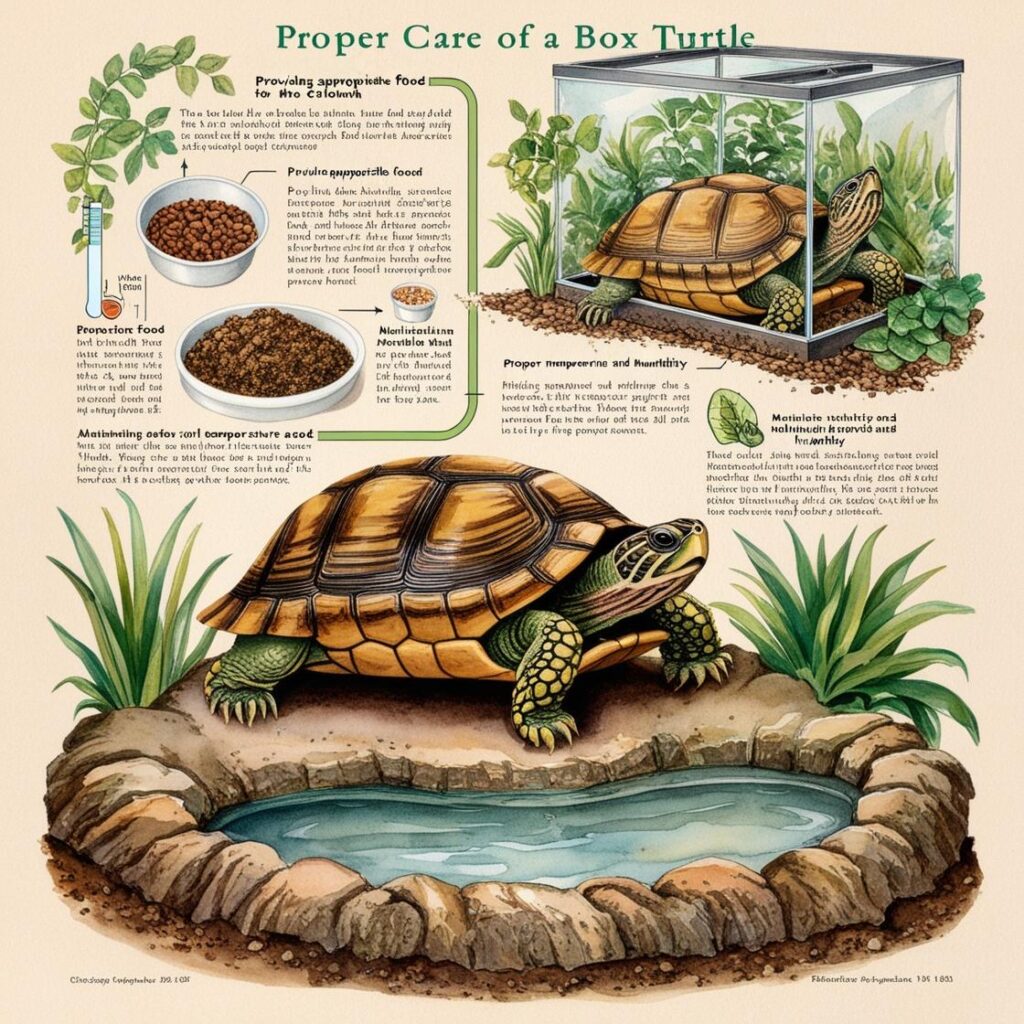Box turtles are fascinating creatures that can make wonderful pets, especially for those interested in reptile care. Their unique appearance, gentle demeanor, and longevity—many can live for over 50 years with proper care—make them intriguing companions. However, they require specific care to thrive in captivity. This comprehensive guide will discuss everything you need to know about taking care of a box turtle, covering habitat setup, diet, health care, and general maintenance.
Understanding Box Turtles
Box turtles are terrestrial reptiles belonging to the family Emydidae, widely known for their domed shells and the ability to completely conceal themselves within their shell, thanks to their hinged plastron. They are native to North America and are usually found in a variety of habitats, including forests, grasslands, and wetlands. Box turtles can vary significantly in size, color, and patterns, with common species including the Eastern box turtle (Terrapene carolina carolina), Western box turtle (Terrapene ornata), and the Three-toed box turtle (Terrapene carolina triunguis).

Basic Behavior and Temperament
Box turtles are generally calm and curious creatures. They are diurnal, meaning they are most active during the day. While they can be quite social and enjoy the company of their owners, they can also be skittish and may retreat into their shells when startled. Understanding their behavior is critical for creating a stress-free environment.
Setting Up the Ideal Habitat
Creating a suitable habitat is crucial for the well-being of a box turtle. Whether you plan to keep your turtle indoors or outdoors, a proper setup will promote their health and happiness.
Indoor Habitat
- Enclosure Size: The size of the enclosure should correspond to the size of the turtle. A single adult box turtle requires at least a 40-gallon terrarium, but larger is always better. If you’re keeping more than one turtle, a larger space is necessary to avoid territorial disputes.
- Substrate: Use a substrate that allows for burrowing and is easy to clean. A mixture of organic soil, coconut coir, and shredded bark works well. This combination supports natural behaviors and provides excellent moisture retention.
- Temperature Control: Box turtles thrive in temperatures between 75°F and 85°F (24°C to 29°C). Provide a basking area with a heat lamp to create a temperature gradient, allowing the turtle to move between warmer and cooler areas. The basking spot should reach about 90°F (32°C).
- Lighting: UVB lighting is essential for box turtles to synthesize vitamin D3, which aids calcium absorption and prevents metabolic bone disease. Provide a UVB bulb with at least 10% output, and replace it every six months, as the light’s effectiveness diminishes over time.
- Humidity: Box turtles require humidity levels between 50-70%. Regular misting, planting live plants, and using a moist substrate can help maintain the desired humidity.
- Water: Provide a shallow water dish for drinking and soaking. The water should be changed daily to prevent bacterial growth and ensure cleanliness.
Outdoor Habitat
If you choose to keep your box turtle outdoors, ensure the environment is safe and secure:
- Enclosure: Build a secure, escape-proof enclosure using sturdy materials. The area should be large enough to allow for roaming, with features like logs, rocks, and plants for enrichment.
- Shade and Shelter: Ensure there are shaded areas where your turtles can escape the heat. Provide hiding spots, such as logs or burrows, to help them feel secure.
- Safety Measures: Protect the enclosure from predators and ensure it is free of harmful plants or substances.
Enrichment
To keep your box turtle active and engaged, provide various enrichment opportunities, including:
- Hiding spots made from natural materials.
- Different substrates to dig through.
- Seasonal changes to the environment to encourage exploration.
Feeding Your Box Turtle
Feeding a box turtle a balanced and varied diet is crucial for its health. These creatures are omnivores, which means they require both animal protein and plant matter.
Ideal Diet
- Commercial Pellets: Quality box turtle pellets can be a reliable staple, but they should not be the sole source of nutrition.
- Fruits and Vegetables: While fruits should be offered in moderation due to high sugar content, leafy greens like kale, collard greens, and dandelion greens should make up a significant portion of their diet. Avoid iceberg lettuce, as it provides minimal nutritional value.
- Protein Sources: Live foods such as earthworms, slugs, crickets, and other insects should be part of their diet. Occasionally, you can offer cooked chicken or fish.
- Calcium and Vitamins: It’s vital to dust food with a calcium supplement several times a week and provide a multivitamin once a week to ensure your turtle receives necessary nutrients to prevent deficiencies.
Feeding Routine
Feed your box turtle every other day. Monitor the amount they consume and adjust portions based on their appetite and activity levels. Fresh and clean water should always be available.
Health Care
Maintaining your box turtle’s health requires vigilant observation and routine care.
Regular Check-Ups
Schedule a veterinary check-up annually. A vet with experience in reptile care can provide guidance tailored to your turtle’s specific needs.
Signs of Health Issues
Monitor your turtle for signs of illness, including:
- Lack of appetite
- Lethargy
- Swelling or discharge from the eyes
- Shell deformities or discoloration
- Changes in behavior or activity levels
If you notice any concerning symptoms, seek veterinary care immediately.
Conclusion
Caring for a box turtle can be both rewarding and challenging. By understanding their needs regarding habitat, diet, and health care, you can create a thriving environment that allows your box turtle to exhibit natural behaviors and live a long, healthy life. While turtles can be an incredible addition to your household, they necessitate ongoing dedication and responsibility. With the right care, you’ll not only enrich the life of your box turtle but also enjoy the incredible experience of bonding with a creature that has been around for millions of years.